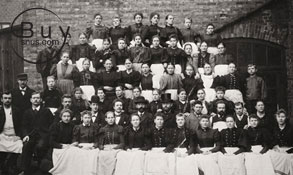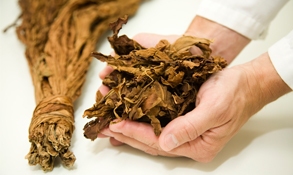
Göteborgs Prima Fint - happiness is a mild snus
According to the headlines, the year 1919 was a rather unsettling one. Although the Versailles Treaty was signed, ending the 1st World War, various conflicts broke out; anarchists were active and on top of everything a volcano erupted in Java. Q: So, was anything created for the benefit of mankind in that year? A: Yes, we saw the invention of the pop-up toaster and of course that mild, slightly sweet snus from Gothenburg.
A classic. Available as loose snus only.
One of the snus manufacturing firms with the longest traditions was founded in 1826 by Mr. Eric Mellgren, a merchant who that year got the permission to start a tobacco business. He already had a small store on the street of Vallgatan where coffee, cocoa and spices were sold. This snus business remained small, with only one employee, until Johan August Mellgren, the son of Eric, took charge of things, turning the store into a factory and expanding production. In 1863, Johan Mellgren was given the permit to install a steam engine for powering the machines.

The human labor force at this time was about 60 people. At the turn of the century, when operations were at their peak, some 100 people were employed. 1902 the factory produced 150 000 kg snus along with 75 000 kg tobacco for cigars and pipes, among them the Sailors Smoking Mixture and Svenska Flaggan, (The Swedish Flag). In the year 1915, the Swedish parliament voted for all tobacco production in Sweden to be nationalized. The purpose was to create funds for national defence and a new pension system. When the monopoly took over, E. Mellgren & Son had been active for 87 years. In 1919 the Swedish monopoly, registers and launches one of the Mellgren recipes as a new brand: Göteborgs Prima Fint, no 930, a fine ground loose snus with a very mild, slightly sweet taste and unseasoned tobacco flavor. This snus is sold as a premium snus for the connaisseur. To this day it has been available as loose snus only.
Keeping it real
This is a premium snus in its most pure form. The Göteborgs Prima Fint is catering to a consumer group that is not very easy to please. Very few changes has been made throughout the years. The recipe remains the same as 1919 and the can has undergone only minor updates, (the most significant would be the dropping of the "n:r 930" from the name). Also, Göteborgs Prima Fint doesn't come in any variations or with any different flavors. You'll get the original, unseasoned tobacco taste. Period. The mild blue color of the can is about as mild as the content, which of course is no coincidence. We leave it open to speculation whether it's the electric trams of Gothenburg (which have been painted in the same color since 1902) or the city of Gothenburg's river location that has been the inspiration for the color.
This is a classic snus that must be enjoyed the way a classic snus was supposed to be enjoyed; in it's easy-to-bake, fine ground, loose quality. And as far as we know the Göteborgs Prima Fint snusers, that's exactly the way that they want it.

Rigorous control - from plant to pouch
It starts in the soil. Before someone even puts a seed in it, soil samples are taken to a laboratory in Sweden for analysis. Swedish Match experiments with cultivation in different countries to achieve the best possible raw tobacco. If declared a good soil for tobacco, seeds are planted and every step in the development and the cultivation of the plant is carefully monitored. The tobacco is selected on the basis of seed type, location, climate, leaf position on the plant and curing conditions. When cultivation have started, representatives from Swedish Match will visit the plantations regularly to ensure that the crops will meet the requirements. There's a simple purpose for all this care: To ensure that the tobacco that ends up being selected for the various snus blends from Swedish Match contains the lowest levels of undesirable components possible. This quality control continues through the entire chain of production; when the leaves are harvested and air-cured; when transported and later sorted in a gianormous, perfectly climatized storehouse. Then, finally, the tobacco will find its way to the factory.
When hi-tech meets a 200 year-old tradition.

In step one, the tobacco leaves are crushed and ground to fine grains; the size of the particles varies with the brand. The tobacco is then carefully mixed into a blend. A blend could contain anything between 10 and 30 different grades of tobacco depending on the recipe. In step two, the tobacco is mixed with the other main snus ingredients; water and salt. It's then time for it to undergo heat treatment, (pasteurization). After being chilled the tobacco meets the different ingredients - spices, natural oils or even bourbon whiskey - that will give the snus that extra flavor and special character. And then, finally, it's time for packaging. Loose snus goes straight into the can. For portions the correct amount of snus is first wrapped in a little pouch. In the Swedish Match factories, there is a zero tolerance for errors. Everything - which means everything - is completely focused on delivering top quality. Sophisticated instruments measure and control the process along with watchful and well trained eyes. The tradition of manufacturing snus is 200 years old in Sweden, but there's nothing traditional or old about the Swedish Match production plant. If your nose wouldn't detect the pleasant scent of tobacco here and there in the manufacturing facility, you could easily picture that parts for a fighter jet were being produced instead of snus. They even invented their own quality standard, GothiaTek. And that certainly did not happen because they wanted to make life easy for themselves. It's very much the other way around. Yes, those Swedes are a tough bunch.
Göteborgs Prima Fint - Mild, slightly sweet and very fine.